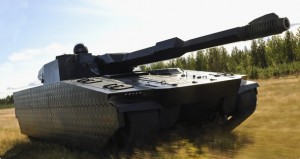'Pixel' covered tank blends into its surroundings

BAE Systems have tested a new camouflaging system called "Adaptive" that can instantly blend a combat vehicle into its natural surroundings by making it invisible to infrared and other surveillance technology.
Adaptiv can also mimic natural objects and other vehicles, and display tags for Identification Friend/Foe (IFF) capability by displaying distinctive patterns visible only at certain spectral ranges or in response to an interrogation signal.
The technology is based on sheets of lightweight hexagonal 'pixels' (panels) that are electrically powered by a vehicle's systems. The metal panels are individually heated and cooled rapidly using semiconducting technology. The hand-sized pixels are not unlike the tiles used on the exterior of space shuttles--they're designed to sustain physical impact and can be easily removed and replaced if damaged.
The system works with on-board cameras that pick up background scenery and display the corresponding infrared image on the vehicle, allowing even a moving tank to match its surroundings and effectively reduce detection range below 500 meters.
While testing has centered on the infrared spectrum, BAE engineers have combined the panels with other technologies to provide camouflage in other parts of the electromagnetic spectrum at the same time to provide all-round stealth. (Perhaps an electronic-ink or a light-bending cloaking device similar to the one in the movie Predator is not too far off.)
Trials by BAE Systems in mid-July showed that one side of a CV90 could be made effectively invisible or appear to be other objects, including a 4x4 vehicle, when viewed in the infrared spectrum. (See video.)
BAE Systems project manager, Peder Sjölund explains: "Earlier attempts at similar cloaking devices have hit problems because of cost, excessive power requirements or because they were insufficiently robust. Our panels can be made so strong that they provide useful armour protection and consume relatively low levels of electricity, especially when the vehicle is at rest in 'stealth recce' mode and generator output is low."
The panels can be used for helicopters, warships and stationary assets. "We can resize the pixels to achieve stealth for different ranges. A warship or building, for instance, might not need close-up stealth, so could be fitted with larger panels," Sjölund said.
Defense Update reports that a similar system is also under development in Israel – ‘Invisible Reactive Armor Protection (IRAP)’ while in the U.S., DARPA and the U.S. Army research and development center have pursued similar capabilities for future iterations of the ‘Manned Ground Vehicle.'
Adaptiv using infrared will be displayed on a BAE Systems CV90 armored vehicle at the UK Defense and Security Equipment International exhibition from September 13-16.
The technology was funded in part by the Swedish Defense Material Administration (FMV).
